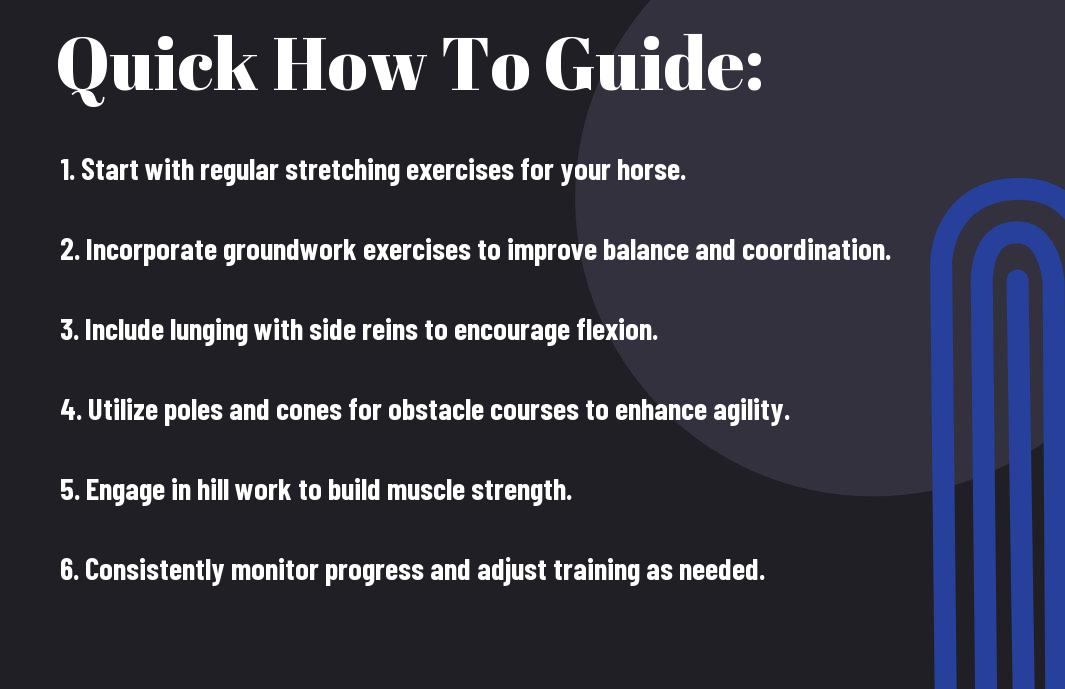Most horse owners know the importance of maintaining their equine companions’ flexibility and strength for their overall health and performance. In this guide, we will explore effective exercises and techniques to help improve your horse’s flexibility and build their strength. By incorporating these strategies into your horse’s training regimen, you can help them become a happier, healthier, and more balanced athlete.


Understanding the Importance of Flexibility and Strength in Horses
For your horse to perform at its best and remain healthy, it is crucial to understand the importance of flexibility and strength. Flexibility allows your horse to move freely and easily, enabling it to perform various movements and tasks effectively. Strength, on the other hand, is necessary to support your horse’s body during exercise and prevent injuries.
Factors Affecting Flexibility and Strength
- Proper warm-up and cool-down routines can increase your horse’s flexibility and prevent muscle stiffness.
- A balanced diet rich in protein and vitamins can help maintain your horse’s muscle strength and overall health.
Recognizing the impact of your horse’s environment, exercise routine, and nutrition on its flexibility and strength is necessary for optimizing its performance and well-being.
Benefits of Improving Flexibility and Strength
The improvement in your horse’s flexibility and strength can lead to enhanced athletic performance, increased range of motion, and decreased risk of injuries. Through targeted exercises and proper conditioning, your horse can reach its full potential and excel in various disciplines.
Understanding how flexibility and strength work together can help you design a training program that addresses your horse’s specific needs and goals. By focusing on these key areas, you can help your horse develop the physical attributes necessary for success in its training and competitions.
Assessing Your Horse’s Current Flexibility and Strength
You can start by evaluating your horse’s current flexibility and strength to determine the areas that need improvement. This will help you tailor your training program to address specific weaknesses and enhance your horse’s overall performance.
How to Evaluate Your Horse’s Range of Motion
Range of motion refers to the extent to which a joint can move in various directions. To assess your horse’s range of motion, you can gently manipulate each joint through its full range of motion and take note of any restrictions or stiffness. Pay attention to how easily your horse can flex, extend, and rotate each joint.
Identifying Areas for Improvement
Any restrictions or stiffness you observe during the range of motion assessment can indicate areas that need improvement. Common problem areas include the neck, back, hindquarters, and legs. By identifying these areas, you can focus on specific exercises and stretches to help increase flexibility and strength in those areas.
Understanding your horse’s current flexibility and strength levels is crucial for developing a targeted training plan. By identifying areas for improvement, you can create a customized exercise routine that will help your horse become more supple, balanced, and powerful in their movements.

Tips for Improving Your Horse’s Flexibility
Keep flexibility in mind as an necessary component of your horse’s overall well-being. A flexible horse is less prone to injuries and performs better in training and competitions. To help improve your horse’s flexibility, consider these tips:
- Regular Stretching: Incorporate stretching exercises into your horse’s routine to increase flexibility in their muscles and joints.
- Proper Warm-Up: Always warm up your horse before any strenuous exercise to prepare their muscles for work and reduce the risk of injury.
- Consistent Training: Regular, consistent training helps maintain and improve your horse’s flexibility over time.
Recognizing the importance of flexibility is the first step towards helping your horse reach their full potential.
Stretching Exercises for Horses
Now, incorporating stretching exercises into your horse’s routine can greatly improve their flexibility. Consider exercises such as neck stretches, leg stretches, and back stretches to target different muscle groups and promote overall suppleness in your horse.
How to Incorporate Flexibility Training into Your Daily Routine
You can gradually introduce flexibility training into your daily routine by starting with a few simple stretches before and after each ride. Focus on areas that may be tight or restricted, and be gentle to avoid causing any discomfort to your horse. Over time, you can increase the intensity and duration of the stretches as your horse becomes more flexible.
Flexibility is key to your horse’s overall performance and well-being, so dedicating time to flexibility training each day can make a significant difference in their physical abilities and overall health.
The Role of Massage and Chiropractic Care in Improving Flexibility
Training your horse regularly is crucial for improving their flexibility, but incorporating massage and chiropractic care can also be beneficial. Massage helps relax tight muscles and improve circulation, while chiropractic adjustments can correct alignment issues and improve overall flexibility and range of motion.
Understanding how massage and chiropractic care can complement your training routine can help you address any underlying issues that may be limiting your horse’s flexibility. Regular sessions with a qualified equine massage therapist and chiropractor can help keep your horse in top physical condition for optimal performance.
Building Strength in Your Horse
Your horse’s strength is vital for their overall health and performance. By focusing on building strength, you can help your horse move more efficiently, prevent injuries, and enhance their athletic abilities.
How to Develop a Strength Training Program for Your Horse
Some key considerations when developing a strength training program for your horse include assessing their current fitness level, setting realistic goals, and gradually increasing the intensity of their workouts. It’s important to tailor the program to your horse’s individual needs and abilities, taking into account factors such as age, breed, and discipline.
Exercises for Building Core Strength and Stability
Program incorporating exercises that target your horse’s core muscles is crucial for improving their overall strength and stability. These exercises can include pole work, hill work, and specific ridden or in-hand exercises that engage the abdominal muscles and encourage proper posture and balance.
This will help your horse develop a strong foundation to support their body during various activities, leading to improved performance and reduced risk of injuries.
The Importance of Gradual Progression and Consistency
Gradual progression and consistency are key in any strength training program for your horse. Rushing into intense workouts or abruptly increasing the difficulty level can lead to muscle strain, fatigue, or even injuries. It’s important to gradually increase the intensity and duration of exercises over time to allow your horse’s muscles to adapt and grow stronger.
Consistency is also crucial in seeing results from your strength training program. Regular, consistent workouts will help maintain and build upon your horse’s strength, ensuring long-term benefits for their overall health and performance.
Nutrition and Supplementation for Optimal Flexibility and Strength
Now, let’s talk about the necessary role that nutrition and supplementation play in improving your horse’s flexibility and strength. Proper nutrition is foundational for overall health and performance, and specific nutrients can support your horse’s musculoskeletal system.
Key Nutrients for Supporting Flexibility and Strength
Strength, your horse’s diet should include **high-quality protein** to support muscle development and repair. **Omega-3 fatty acids**, found in sources like flaxseed and fish oil, can help reduce inflammation and support joint health. **Vitamin E** is crucial for muscle function and overall performance, while **minerals** such as **calcium, phosphorus, and magnesium** play a role in bone strength and muscle contractions. Ensuring your horse has a balanced diet rich in these nutrients can positively impact their flexibility and strength.
How to Choose the Right Supplements for Your Horse
Optimal supplementation can complement your horse’s diet and provide additional support for their flexibility and strength. When opting for supplements for your horse, **consider their individual needs**. **Joint supplements** containing ingredients like **glucosamine and chondroitin** can help support your horse’s joint health and mobility. Look for supplements that are **specifically formulated for horses** and **backed by research**. Discussing supplementation with your veterinarian or equine nutritionist can help you tailor a regimen that best suits your horse’s requirements.
With **careful consideration** and guidance, you can enhance your horse’s flexibility and strength through a combination of proper nutrition and targeted supplementation. Remember to **monitor their progress** and make adjustments as needed to support their optimal performance and well-being.

Common Mistakes to Avoid When Improving Flexibility and Strength
Overexertion and Injury Prevention
To improve your horse’s flexibility and strength, you need to be mindful of how much you are asking of them. Some common mistake is overexerting your horse without giving them enough time to rest and recover, which can lead to injuries. It’s important to listen to your horse’s cues – if they are showing signs of fatigue or strain, it’s crucial to give them a break.
Avoiding Plateaus and Stagnation
Now, when working on improving your horse’s flexibility and strength, it’s vital to vary their exercises and routines. Some riders make the mistake of sticking to the same routine for too long, which can lead to plateaus where your horse stops making progress. Keep challenging your horse with new exercises and movements to keep them engaged and continue seeing improvements.
This could mean incorporating different types of exercises such as lateral work, cavaletti exercises, or pole work. By keeping your horse mentally stimulated and physically challenged, you can prevent them from hitting a plateau in their training.
Final Words
As a reminder, improving your horse’s flexibility and strength is key to maintaining their overall health and performance. By incorporating regular stretching exercises, ground poles, and cavaletti work into your horse’s training routine, you can help them develop better balance and coordination while reducing the risk of injuries. Remember to always listen to your horse’s body and progress gradually to avoid straining their muscles or joints. Consistency and patience are key when it comes to seeing improvements in your horse’s flexibility and strength.
Q: Why is flexibility important for horses?
A: Flexibility is important for horses because it helps prevent injuries, allows for better range of motion, and enhances overall performance.
Q: How can I improve my horse’s flexibility?
A: You can improve your horse’s flexibility through regular stretching exercises, proper warm-up routines, and incorporating exercises such as lunging and pole work into your training program.
Q: Why is strength important for horses?
A: Strength is important for horses because it helps support their body weight, improve balance, and prevent fatigue during performance activities.
Q: What exercises can help increase my horse’s strength?
A: Exercises such as hill work, trot and canter sets, and cavaletti training can help increase your horse’s strength and endurance.
Q: How often should I work on improving my horse’s flexibility and strength?
A: Aim to incorporate flexibility and strength training exercises into your horse’s routine at least 2-3 times per week, while ensuring proper rest and recovery periods between sessions.











